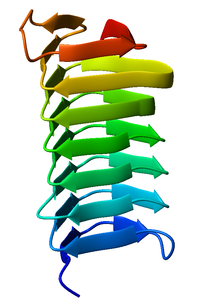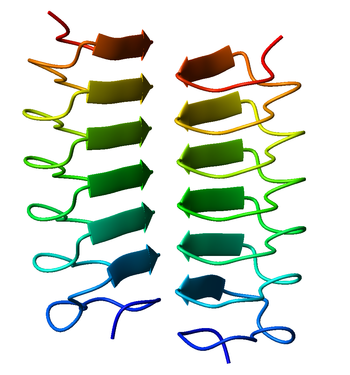
Beta helix
Encyclopedia


Protein
Proteins are biochemical compounds consisting of one or more polypeptides typically folded into a globular or fibrous form, facilitating a biological function. A polypeptide is a single linear polymer chain of amino acids bonded together by peptide bonds between the carboxyl and amino groups of...
structure formed by the association of parallel beta strands
Beta sheet
The β sheet is the second form of regular secondary structure in proteins, only somewhat less common than the alpha helix. Beta sheets consist of beta strands connected laterally by at least two or three backbone hydrogen bonds, forming a generally twisted, pleated sheet...
in a helical pattern with either two or three faces. The structure is stabilized by inter-strand hydrogen bond
Hydrogen bond
A hydrogen bond is the attractive interaction of a hydrogen atom with an electronegative atom, such as nitrogen, oxygen or fluorine, that comes from another molecule or chemical group. The hydrogen must be covalently bonded to another electronegative atom to create the bond...
s, protein-protein interaction
Protein-protein interaction
Protein–protein interactions occur when two or more proteins bind together, often to carry out their biological function. Many of the most important molecular processes in the cell such as DNA replication are carried out by large molecular machines that are built from a large number of protein...
s, and sometimes bound metal ion
Ion
An ion is an atom or molecule in which the total number of electrons is not equal to the total number of protons, giving it a net positive or negative electrical charge. The name was given by physicist Michael Faraday for the substances that allow a current to pass between electrodes in a...
s. Both left- and right-handed beta helices have been identified.
Two-stranded helices
The simplest beta helix contains two "layers" of beta sheets connected by glycineGlycine
Glycine is an organic compound with the formula NH2CH2COOH. Having a hydrogen substituent as its 'side chain', glycine is the smallest of the 20 amino acids commonly found in proteins. Its codons are GGU, GGC, GGA, GGG cf. the genetic code.Glycine is a colourless, sweet-tasting crystalline solid...
-rich six-residue loops that invariably contain an aspartate to bind one calcium
Calcium
Calcium is the chemical element with the symbol Ca and atomic number 20. It has an atomic mass of 40.078 amu. Calcium is a soft gray alkaline earth metal, and is the fifth-most-abundant element by mass in the Earth's crust...
ion per loop. Each layer consists of a nearly-planar series of parallel hydrogen-bonded beta strands and the two layers together enclose a hydrophobic core.
Three-stranded helices
Three-stranded beta helices form a distorted triangular prism shape in which each face exhibits parallel inter-strand hydrogen bonding. One of the three sheets that form the repeating structural motifStructural motif
In a chain-like biological molecule, such as a protein or nucleic acid, a structural motif is a supersecondary structure, which appears also in a variety of other molecules...
can appear "bent" relative to the other two, which face each other as in the two-stranded helix. Two of the three linking loops between the sheets can be of arbitrary length and can even contain other structural domains; the third is restricted to two resides. A characteristic common hexapeptide repeat found in both left- and right-handed helices is the sequence
 . Known three-stranded helices are appreciably longer than their two-stranded counterparts.
. Known three-stranded helices are appreciably longer than their two-stranded counterparts.The first beta-helix was observed in the enzyme pectate lyase
Pectate lyase
Pectate lyase is an enzyme involved in the maceration and soft rotting of plant tissue. Pectate lyase is responsible for the eliminative cleavage of pectate, yielding oligosaccharides with 4-deoxy-alpha-D-mann-4-enuronosyl groups at their non-reducing ends. The protein is maximally expressed late...
, which contains a seven-turn helix that reaches 34 Å (3.4 nm) long. The P22 phage
P22 phage
The P22 virus is a lysogenic bacteriophage that infects Salmonella. Its linear, double-stranded DNA genome is 44 kilobases long. Like many phage viruses, it has been used in molecular biology to induce mutations in cultured bacteria and to introduce foreign genetic material. The viral capsid has...
tailspike protein, a component of the P22 bacteriophage
Bacteriophage
A bacteriophage is any one of a number of viruses that infect bacteria. They do this by injecting genetic material, which they carry enclosed in an outer protein capsid...
, has 13 turns and in its assembled homotrimer is 200 Å (20 nm) in length. Its interior is close-packed with no central pore and contains both hydrophobic residues and charged residues neutralized by salt bridge
Salt bridge
A salt bridge, in chemistry, is a laboratory device used to connect the oxidation and reduction half-cells of a galvanic cell , a type of electrochemical cell...
s.
Both pectate lyase and P22 tailspike protein contain right-handed helices; left-handed versions have been observed in enzyme
Enzyme
Enzymes are proteins that catalyze chemical reactions. In enzymatic reactions, the molecules at the beginning of the process, called substrates, are converted into different molecules, called products. Almost all chemical reactions in a biological cell need enzymes in order to occur at rates...
s such as UDP-N-acetylglucosamine acyltransferase and archaeal carbonic anhydrase
Carbonic anhydrase
The carbonic anhydrases form a family of enzymes that catalyze the rapid interconversion of carbon dioxide and water to bicarbonate and protons , a reversible reaction that occurs rather slowly in the absence of a catalyst...
. Other proteins that contain beta helices include the antifreeze
Antifreeze
Antifreeze is a freeze preventive used in internal combustion engines and other heat transfer applications, such as HVAC chillers and solar water heaters....
proteins from the beetle Tenebrio molitor (right-handed) and from the spruce budworm, Choristoneura fumiferana (left-handed), where regularly spaced threonine
Threonine
Threonine is an α-amino acid with the chemical formula HO2CCHCHCH3. Its codons are ACU, ACA, ACC, and ACG. This essential amino acid is classified as polar...
s on the β-helices bind to the surface of ice
Ice
Ice is water frozen into the solid state. Usually ice is the phase known as ice Ih, which is the most abundant of the varying solid phases on the Earth's surface. It can appear transparent or opaque bluish-white color, depending on the presence of impurities or air inclusions...
crystals and inhibit their growth.
Beta helices can associate with each other effectively, either face-to-face (mating the faces of their triangular prisms) or end-to-end (forming hydrogen bonds). Hence, β-helices can be used as "tags" to induce other proteins to associate, similar to coiled coil
Coiled coil
A coiled coil is a structural motif in proteins, in which 2-7 alpha-helices are coiled together like the strands of a rope . Many coiled coil type proteins are involved in important biological functions such as the regulation of gene expression e.g. transcription factors...
segments.

